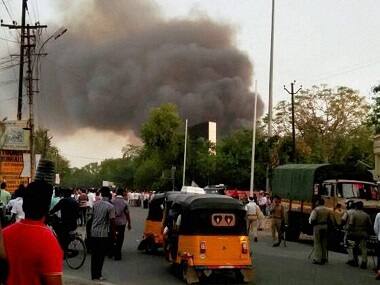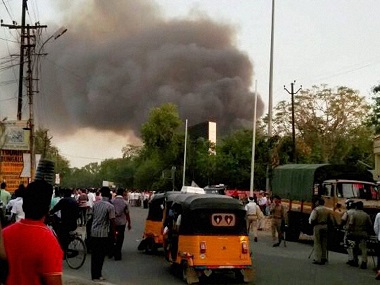The unprecedented violence in Mathura on the night of Thursday 2 June has once again raised questions on the intelligence-gathering ability of the Uttar Pradesh police which has resulted in policemen being targets of mob violence in dozens of cases in the past two years. While in Mathura, the district police appeared to have taken the operation quite lightly in the beginning, the scale of preparedness of the squatters took the cops completely by surprise, leading to 24 deaths, including of two police officers. In fact, initial reports have suggested that the operation was planned for 4 June and the 2 June move was more of a rehearsal. The police team had tried to break a part of the boundary wall and move in to see if they could chase away the squatters. The response they received was unprecedented. The squatters, calling themselves the members of the Swadhin Bharat Vidhik Vaicharik Satyagrah, have been demanding abolition of elections and cheaper fuel. They had under their control nearly 280 acres of land in Jawahar Bagh which used to be a vast green park having fruit trees and flower beds. However ever since the Satyagrah followers started living there, most of the trees had been cut down and temporary sheds had come up. The entry of horticulture department employees too had been stopped by the squatters who had been caught in many a fracas with local citizens. [caption id=“attachment_2815792” align=“alignleft” width=“380”]
 The violence in Mathura. PTI[/caption] Mathura is a bustling temple town with thousands of pilgrims visiting the Krishna Janmabhoomi and other temples every day round the year. There is a big presence of policemen in the temple area where a mosque stands adjacent to the Krishna Janmabhumi temple. It is also headquarters of the Baba Jai Gurudev organization from which the Mathura squatters’ leader Ram Vriksh Yadav had broken away some years ago. It had been hit by a severe Hindu-Muslim riot in Kosi Kalan in June 2012, a few months after the Samajwadi Party government headed by Akhilesh Yadav had taken over the state. The riots had been sparked off by a minor altercation between youths of the two communities and at the end of the three-day violence the death toll had risen to five. More recently, there was a clash between youths from Dalit and Thakur community in which many people were injured. Thursday’s incident has caused widespread alarm in Mathura, with locals expressing their anger over the prolonged inaction by the district administration and the police in evicting the illegal occupants in the park for more than two years. It took a court order to lead the administration to launch the operation. It could well have been rounded off with a massive show of strength by the police and hundreds of arrests. But the police strategy had three major flaws: -There was no intelligence input about the presence of arms such as guns, pistols, rifles, and ammunition, swords, knives, bombs and grenades within the park premises. It is learnt that the local police avoided going inside the park started even after complaints from neighbouring residents, and on the other hand armed youths from among the squatters used to patrol the park at nights. -The police started their operation initially with a small team, and it was expected that they would succeed in chasing away the inmates after entering the park. But there was no clarity even on how many people were inside the park at that time early last evening. According to the police the squatters appeared well-trained in the use of firearms of all kinds. Eye-witnesses were quoted as saying that women and elderly persons were also helping to load the weapons and handling ammunition. Many of them had climbed atop trees and were firing from there, targeting policemen. Reinforcements were summoned after the situation appeared going out of hand. -There was considerable delay in ordering the policemen to open fire on the attackers. Locals say that the policemen were waiting for orders even after being attacked, and it was only after the station officer Santosh Yadav was hit on his face by two bullets that the police started firing. There have been many incidents of policemen being attacked by criminals in the past two years, and many policemen have lost their lives and several injured while facing attacks. But the Mathura incident is the most serious where the police had to face firing and attack from people apparently trained in guerilla attacks. Attacks on police have increased during the present Samajwadi Party regime in the state. According to statistics tabled before the UP Assembly recently, attacks on police have increased by more than three times in the last eight years and doubled during the present government as compared to similar incidents during the Bahujan Samaj Party rule. The number of attacks on police shot up to 300 in 2014-15. In many incidents, policemen have been murdered while discharging their duty. Such killings have taken place in Varanasi, Kunda in Pratapagrh, Pilibhit and Badaun, Agra and Ferozabad. The state government has decided to slap the National Security Act (NSA) on those involved in such cases. The state’s Director General of police Javed Ahmed has said that NSA would be invoked against those attacking cops and police stations. The issue is now open to political allegations and counter-allegations and the state government has little defense. In any case, charges of inaction on the law and order front, rising crime and helpless police have frequently been leveled against the Samajwadi Party government.
The violence in Mathura. PTI[/caption] Mathura is a bustling temple town with thousands of pilgrims visiting the Krishna Janmabhoomi and other temples every day round the year. There is a big presence of policemen in the temple area where a mosque stands adjacent to the Krishna Janmabhumi temple. It is also headquarters of the Baba Jai Gurudev organization from which the Mathura squatters’ leader Ram Vriksh Yadav had broken away some years ago. It had been hit by a severe Hindu-Muslim riot in Kosi Kalan in June 2012, a few months after the Samajwadi Party government headed by Akhilesh Yadav had taken over the state. The riots had been sparked off by a minor altercation between youths of the two communities and at the end of the three-day violence the death toll had risen to five. More recently, there was a clash between youths from Dalit and Thakur community in which many people were injured. Thursday’s incident has caused widespread alarm in Mathura, with locals expressing their anger over the prolonged inaction by the district administration and the police in evicting the illegal occupants in the park for more than two years. It took a court order to lead the administration to launch the operation. It could well have been rounded off with a massive show of strength by the police and hundreds of arrests. But the police strategy had three major flaws: -There was no intelligence input about the presence of arms such as guns, pistols, rifles, and ammunition, swords, knives, bombs and grenades within the park premises. It is learnt that the local police avoided going inside the park started even after complaints from neighbouring residents, and on the other hand armed youths from among the squatters used to patrol the park at nights. -The police started their operation initially with a small team, and it was expected that they would succeed in chasing away the inmates after entering the park. But there was no clarity even on how many people were inside the park at that time early last evening. According to the police the squatters appeared well-trained in the use of firearms of all kinds. Eye-witnesses were quoted as saying that women and elderly persons were also helping to load the weapons and handling ammunition. Many of them had climbed atop trees and were firing from there, targeting policemen. Reinforcements were summoned after the situation appeared going out of hand. -There was considerable delay in ordering the policemen to open fire on the attackers. Locals say that the policemen were waiting for orders even after being attacked, and it was only after the station officer Santosh Yadav was hit on his face by two bullets that the police started firing. There have been many incidents of policemen being attacked by criminals in the past two years, and many policemen have lost their lives and several injured while facing attacks. But the Mathura incident is the most serious where the police had to face firing and attack from people apparently trained in guerilla attacks. Attacks on police have increased during the present Samajwadi Party regime in the state. According to statistics tabled before the UP Assembly recently, attacks on police have increased by more than three times in the last eight years and doubled during the present government as compared to similar incidents during the Bahujan Samaj Party rule. The number of attacks on police shot up to 300 in 2014-15. In many incidents, policemen have been murdered while discharging their duty. Such killings have taken place in Varanasi, Kunda in Pratapagrh, Pilibhit and Badaun, Agra and Ferozabad. The state government has decided to slap the National Security Act (NSA) on those involved in such cases. The state’s Director General of police Javed Ahmed has said that NSA would be invoked against those attacking cops and police stations. The issue is now open to political allegations and counter-allegations and the state government has little defense. In any case, charges of inaction on the law and order front, rising crime and helpless police have frequently been leveled against the Samajwadi Party government.
Mathura violence: UP police were outnumbered and clueless
Ratan Mani Lal
• June 3, 2016, 18:01:47 IST
The unprecedented violence in Mathura on the night of Thursday 2 June has once again raised questions on the intelligence-gathering ability of the Uttar Pradesh police.
Advertisement
)
End of Article